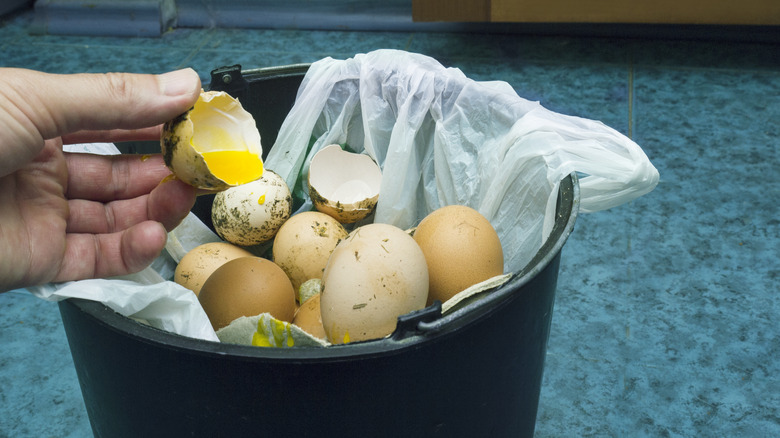If You See This Egg Color Change, Throw It Out
While eggs are an endlessly versatile staple in American cuisine and beyond, there's no denying they can pose a health risk if cooked incorrectly. According to the CDC, raw eggs can easily be contaminated with bacteria, the most common of which is salmonella. Even if eggs are washed before they end up in grocery stores, salmonella can occasionally grow inside the hens before they lay eggs. And, although this is much rarer in today's world, salmonella is best avoided – Mayo Clinic shares that contracting the disease can lead to fever, vomiting, chills, and more (no thank you).
While egg safety procedures have made leaps and bounds over the past century, we still have a long way to go. According to The PEW Charitable Trusts, salmonella causes about 1 million illnesses every year and outbreaks associated with chicken rose between 2000 to 2018.
So, how can you ensure safe egg handling? Correct storage is key and the U.S. Food and Drug Administration recommends only buying refrigerated eggs, ensuring the shells are not cracked before purchasing, and keeping them in a refrigerator at 40 degrees Fahrenheit or below. And, when checking your eggs to see if they've gone bad, make sure to pay attention to this color change.
A pink and green egg is a rotten egg
It can be difficult to tell from the outside if your eggs have gone bad, so to ensure your morning omelet won't give you salmonella, try cracking one of the eggs into a bowl first. According to Australian Eggs, a good egg will have a semi-thick white and a vivid orange or yellow yolk. A bad egg, however, may have a pink, slightly green, or iridescent egg white, Food Network shares. If you see any of these shades after cracking your egg, run (or just throw the egg out) -– these can be signs of harmful bacteria that can make you sick. Healthline advises using a white bowl or plate to do your testing, so you can clearly see if the colors are off.
There are also several ways to tell if your egg is bad before cracking it open. Try performing a float test, which involves gently sliding your eggs into a bowl of cold water — any bad eggs will float (via Australian Eggs). Alternatively, hold the egg up to your ear and shake it. If you don't hear anything, the egg is probably fine, but if you hear liquid sloshing around, the yolk has most likely gone bad, according to Southern Living.
And if you smell rotten eggs, you've probably got your answer right there — no extra tests necessary.

